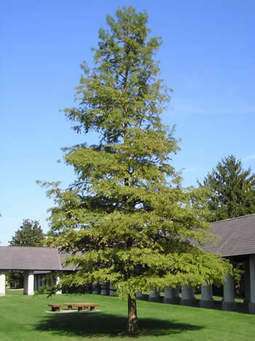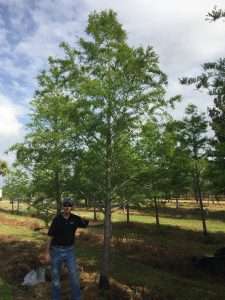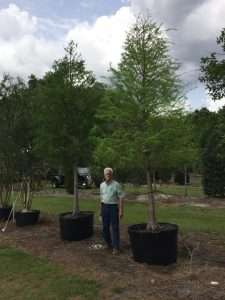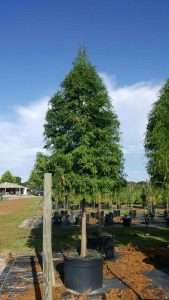BALD CYPRESS

Florida’s Premiere Tree Installer, The Tree Planters located in Lakeland, is your #1 source for large, rare, and exotic palms and trees. At The Tree Planters, we have installed and transplanted thousands of large trees of every variety all over Florida for over 50 years. Every tree we sell, we plant. Every tree we plant, we guarantee for One Full Year.
Delivery is included in the price of your tree. We proudly serve the entire state of Florida. (All other delivery fees will be quoted at time of purchase), and a One-Year Guarantee on every tree planted by The Tree Planters.
“Note from Joel”
Easy to plant, hard to kill. Resistant to everything. Perfect for extremely wet spots, even on the edge of your lake. Don’t plant it in your pool though, too much chlorine.
A Floridata Plant Profile 108 Taxodium distichum
Common Names: bald-cypress, baldcypress
Family: Taxodiaceae (bald-cypress Family)
A Floridata Plant Profile 108 Taxodium distichum
Common Names: bald-cypress, baldcypress
Family: Taxodiaceae (bald-cypress Family)
Description
There are two forms of “cypress” trees in the southeastern U.S. Some authorities consider them to be varieties of a single species, but other experts refer to them as two distinct species. The current trend seems to be that they are distinct species, so Floridata will treat them that way. Bald-cypress (Taxodium distichum) has linear leaves, whereas pond-cypress (T. ascendens) has awl shaped or scale like leaves. The leaves of bald-cypress spread out on the branches, but those of pond-cypress are closely adpressed to the branches. The leaves of bald-cypress are arranged in two ranks on opposite sides of the stem, whereas those of pond-cypress are overlapping. The branchlets of bald-cypress tend to spread outward, while those of pond-cypress are more ascending.
The Bald Cypress is a large tree, to more than 130 ft (40 m) tall, with a trunk diameter at breast height of up to 10 ft (3 m) or more. The young tree is pyramid shaped, but with age the top flattens and the crown may spread as much as 60 ft (18 m) or more. The lower trunk is often greatly enlarged and buttressed. The bark is reddish gray or brown with long fibrous ridges that peel off in strips. Unusual among coniferous needle bearing trees, bald-cypress is deciduous. The needles turn rusty brown, then almost red before dropping in late fall or early winter. Bald-cypresses, especially when growing in or near the water, produce tapered “knees” to 6 ft (2 m) high that stick up from the roots. The cones, maturing in late summer, are round and about an inch (2.5 cm) in diameter.
Location
Bald-cypress, Taxodium distichum, occurs naturally in swamps, flood plains and along the edges of lakes and rivers on the southeastern U.S. Coastal Plain from southeastern Delaware to southern Texas and up the Mississippi Valley to southern Illinois.
Culture
Bald-cypress likes an acidic soil and will develop yellowing of the leaves if grown in neutral or calcareous soils. Young trees grow rapidly, but they can live 500 years or more.
Light: Young seedlings and saplings can tolerate light shade, but they will need full sun to reach their maximum potential.
Moisture: Although they occur naturally in the wettest of places, bald-cypress will thrive in normal, even dry soil. I long ago learned from an old forester that plants don’t grow where they grow best; they grow where they can get away with it. Bald-cypress is just about the only tree that can survive long periods of flooding. But, it will grow faster, larger, and be healthier if not subjected to flooding at all. Bald-cypress doesn’t often get the chance to grow in rich, well drained soils because other trees (that can’t tolerate prolonged flooding) out-compete it. Established bald-cypress trees are surprisingly tolerant of drought.
Hardiness: USDA Zones 5 – 10.


